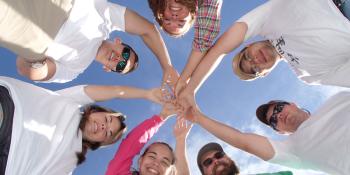
What you need to know about alternative break trips
Bryan Reaka (in green T-shirt) led this Collegiate Challenge trip to Durango, Colorado, in May 2014. Reaka has led or participated in more than 40 of Habitat’s Collegiate Challenge volunteer trips.
Every year, thousands of young volunteers join together to build locally with Habitat for Humanity across the United States.
Through Habitat’s Collegiate Challenge alternative break volunteer trips, young people ages 18-25 team up in groups of five or more for a week of building strength, stability and self-reliance alongside future Habitat homeowners.
Collegiate Challenge trips differ from some of Habitat’s other volunteer trips in that they are open only to groups, rather than to individuals. Past groups who have participated have formed their teams from the membership rolls of student organizations or church groups or sometimes simply been a handful of friends looking to make a difference in a community. On occasion, multiple Collegiate Challenge teams meet up to build together during a trip; on others, a single Collegiate Challenge group is the only one building in the community they visit.
Once a group is formed up and interested in participating, they designate one person as team leader who becomes the contact person for Habitat. Their first step is to pick a Habitat location and work week from the site lists provided online and then to register their team.
Bryan Reaka, an associate professor at Western Kentucky University, first volunteered through Habitat’s Collegiate Challenge trips when he was a student at Eastern Illinois University. He is now the faculty adviser for Habitat’s campus chapter at WKU.
Reaka has participated in about 40 Collegiate Challenge trips and knows the ins and outs of what makes a trip a success.
His first tip: Consider a destination eight to 10 hours away by car. Cost can play a very large part in deciding if a site is the right trip for a group, since the trip will have a budget it must stay within.
At WKU, Reaka works with a student leader who looks at the sites that are available during their break week and gathers information about accommodations, directions and what is provided by the host. (Habitat host sites provide a place to sleep, shower and prepare meals; some locations may include meals for their visiting teams, but that is optional and varies from site to site.)
Another approach, Reaka says, is to choose a location first, see where your group might be interested in traveling and try to match up site availability.
Once decisions have been made and a team is successfully through the registration process, it’s soon time to be on the build site. Participating volunteers receive an orientation about the work they’ll be doing, which varies depending on where the build they are joining is in its forward progress.
That’s when the real experience begins. “Working with the family is amazing,” Reaka says. “In every trip that I’ve been on, when you get to work with them, that helps to solidify why you’re doing what you’re doing.”
His time watching students work with each other and future Habitat homeowners, reflect on each day’s events and ultimately have that moment when it all comes together continues to motivate Reaka, even after dozens of trips.
“That’s why I continue to do this, to watch these young people ‘get it.’ Once they get it, I just sit back and let them go,” he says.
Interested in putting together a group for one of Habitat’s Collegiate Challenge volunteer trips? Learn more.
Youth Programs e-newsletter
Stay in touch with all the latest Habitat for Humanity news and volunteer opportunities for youth. Sign up for our e-newsletter today.
